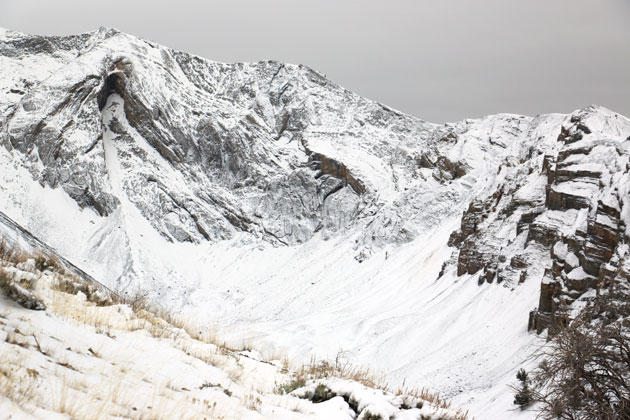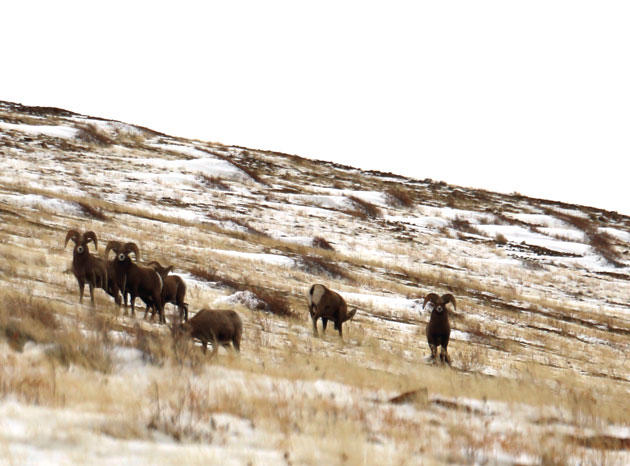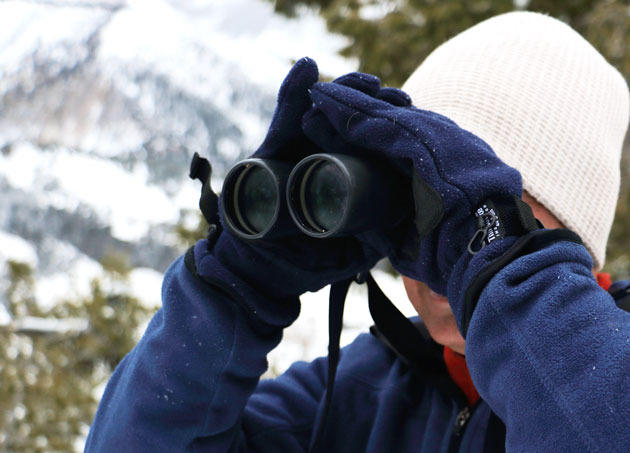The wind screams through the seam around the door. The more the gusts wail, the less I want to get out of the truck. But the snowstorm doesn’t faze Gerald Walters, who’s behind the wheel. He collects data on wild sheep for the Idaho Department of Fish and Game and the US Forest Service. He prepares me for the day’s hike as he rolls down his window and glasses the peaks.
“Bighorns like high, rocky places—what I call nasty country,” he says. “They’re up in the middle of God’s country on top of the world.”
He’s referring to the Lost River Range, home to Idaho’s tallest peaks, including Mount Borah, the state’s highest at 12,662 feet above sea level. In the summer, I admire the range from afar, but its terse, unwelcoming terrain knots my stomach as we now approach.
Walters looks at me for the signal to go. I slowly nod my head, ignoring my instinct to hide in the truck.

Walters hikes with enthusiasm. He’s spent more than a decade studying the range’s bighorns, and he’s lean from the rugged research. He’s lost so much weight chasing sheep that his jeans no longer fit and his belt is over-cinched.
We break the tree line before noon. A final evergreen stands between us and a wide swath of loose shale, where the bighorns await.
“You can look at these magnificent, majestic animals and sense the struggle they’ve had,” Walters says.
In the late 1980s a pneumonia outbreak spread among the range’s 400 bighorns, killing nearly 75 percent of them. By 2000 the herd had shrunk to an estimated 55 sheep.
Walters began monitoring the herd in 2003, as well as implementing measures to strengthen it.
The forest service—with Walters and his colleagues’ input—started coaxing local ranchers to graze cattle instead of sheep, hoping to prevent another disease from spreading between livestock and the wild bighorns. Likewise, in 2005 a combined effort by state and federal wildlife agencies transplanted 62 bighorns from Montana to the Lost River Range to bolster the local herd. Together these efforts helped the bighorn population grow to 240 sheep by 2010.
“It’s been beyond our expectations,” Walters says. “What makes me proudest is the work everybody has done to get where we are today.”
I slowly lean around the last tree trunk standing between me and the herd and spot six cinnamon-colored rams. They’re the reigning kings of this rebounding herd and not easily fooled. They stare back at me but don’t move, grazing without a hint of apprehension. I drop to my knees and start shooting footage. The rams seem to know the hunt here ended a few weeks ago; they have no reason to run.
Each year the state issues seven bighorn tags for this unit, and the tag holders try for trophy rams. In 2013 Susan Collins was one of those hunters.
“It was like winning the lottery,” she says. “I was raised in the valley. In the 70s and 80s we’d see sheep back here, then they disappeared. You just didn’t see them. I didn’t realize how much they’d come back until I went on this hunt.”
Her outing lasted longer than a week, and she saw sheep, including 40 rams, during each of her daily ten-mile hikes.
Other hunters in the area boasted similar success, which the nearby town of Mackay, population 494, welcomes.
“Anything we can do to attract people to our valley will help,” says Otto Higbee, the town’s former mayor. “As the herd increases and there are more permits out there, we’ll get more hunters here and have more people contributing to the economy.”

As my face freezes in the cold, I watch Gerald Walters survey the herd.
“It’s a big deal for me, having been at this for such a long time,” he says. “These sheep are a part of western culture and a part of Idaho.”
He doesn’t take his eyes off the rams as they posture for dates with the ewes. A herd almost lost is now found—but Walters’ gaze refuses to yield. +++
Millgate is an outdoor journalist based in Idaho Falls, Idaho. See her work at tightlinemedia.com.
Be sure to subscribe to our daily newsletter to get the latest from Sporting Classics straight to your inbox.

